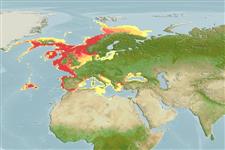Common names from other countries
Environment: milieu / climate zone / depth range / distribution range
Ekologi
; kisaran kedalaman 2 - 1200 m (Ref. 85345). Temperate
Atlantic and the Mediterranean Sea: England. Temperate and subtropical.
Length at first maturity / Size / Weight / umur
Maturity: Lm ? range ? - ? cm
A subsurface deposit feeder (Ref. 96501).
Life cycle and mating behavior
Kematangan | Reproduksi, perkembang biakan | Pemijahan | telur-telur | Fecundity | Larva
Members of the class Ophiuroidea are mostly gonochoric, others are protandric. Fertilization is external. Brooding is common, bursae is used as brood chambers where the embryos develop into juveniles and later crawl out from the bursal slits. Life cycle: Embryos hatch into free-swimming planktotrophic larvae and later metamorphose into tiny brittle stars which sink down the bottom where they grow into adult form.
rujukan utama
Acuan | Koordinator | mitra
Jennings, S., J. Lancaster, A. Woolmer and J. Cotter. 1999. (Ref. 3123)
Status IUCN Red List (Ref. 130435)
status CITES (Ref. 108899)
Not Evaluated
Not Evaluated
penggunaan manusia
| FishSource |
Alat, peralatan
informasi lanjut
Umur / SaizPertumbuhanpanjang-beratpanjang-panjangMorfologiLarvaKelimpahan
Sumber internet
Estimates based on models
Preferred temperature
(Ref.
115969): 5.3 - 13.2, mean 7.6 (based on 360 cells).
kategori harga
Unknown.
